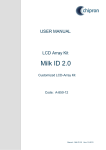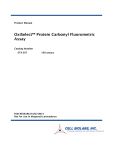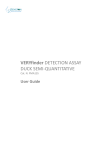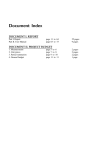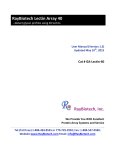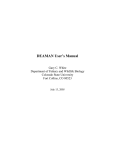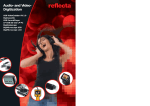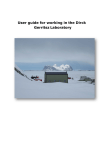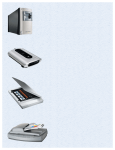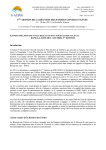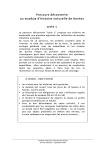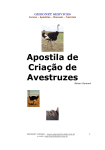Download SPECIES 2.0
Transcript
USER MANUAL LCD Array Kit SPECIES 2.0 DNA-based identification of Animal species Code: A-750-04 Code: A-750-12 1 Manual : SPECIES 2.0 Vers 1.0-2012 1 Product information ................................................................................................................................. 3 1.1 Intended use ................................................................................................................................. 3 1.2 Test principle................................................................................................................................. 4 2 Storage conditions & kit content.............................................................................................................. 5 3 Equipment and reagents - not supplied with the kit ................................................................................ 6 4 Preparation of reagents........................................................................................................................... 6 5 Warnings and precautions....................................................................................................................... 7 6 General safety information ...................................................................................................................... 7 7 Method description .................................................................................................................................. 8 7.1 PCR............................................................................................................................................... 8 7.2 Hybridisation / Detection ............................................................................................................... 8 8 Array description ..................................................................................................................................... 9 9 Protocol ................................................................................................................................................. 10 9.1 9.2 9.3 10 11 PCR amplification........................................................................................................................ 10 9.1.1 PCR set-up ..................................................................................................................... 10 9.1.2 Template ......................................................................................................................... 10 9.1.3 Cycler settings ................................................................................................................ 11 9.1.4 Agarose gel examination ................................................................................................ 11 LCD Array hybridisation and detection ....................................................................................... 11 9.2.1 Hybridisation ................................................................................................................... 12 9.2.2 Labelling.......................................................................................................................... 13 9.2.3 Staining ........................................................................................................................... 13 Short protocol.............................................................................................................................. 14 Analysis and interpretation of the results .............................................................................................. 15 10.1 General remarks ........................................................................................................................ 15 10.2 Methods of analysis ................................................................................................................... 15 10.2.1 Analysis by simple optical examination with naked eye ............................................... 15 10.2.2 Analysis by transmission light scanning and SlideReader software ............................ 15 Device performance .............................................................................................................................. 16 11.1 Sensitivity ................................................................................................................................... 16 11.2 Determination of device performance........................................................................................ 17 12 Device limits .......................................................................................................................................... 18 13 Trouble shooting.................................................................................................................................... 18 14 Literature ............................................................................................................................................... 19 15 Order information................................................................................................................................... 20 16 Contact manufacturer............................................................................................................................ 20 17 Symbol key ............................................................................................................................................ 20 2 Manual : SPECIES 2.0 Vers 1.0-2012 Instructions for use Instructions version: 1 Revised : 26-July-2012 Product information Product name: 1.1 SPECIES 2.0 V-1.0-2012-ENG LCD Array Kit SPECIES 2.0 Order code Kit size A-750-04 32 Tests / 04 Chips A-750-12 96 Tests / 12 Chips Intended use This array has been developed for rapid, easy and reliable identification of animal DNA in fresh meat preparations and products manufactured thereof. DNA of animal species most commonly used in food production will be detected in parallel using extracted DNA as starting material. Beef Bos taurus Mallard Duck Anas platyrhyncos Buffalo Bubalus bubalis Muscovy Duck Cairina moschata Pork Sus scrofa Dog Canis lupus (familiaris) Sheep Ovis aries Cat Felis catus Goat Capra hircus Kangaroo M. giganteus / M. rufus Horse Equus caballus Ostrich Struthio camelus Donkey Equus asinus Bison Bos bison Rabbit Oryctolagus cuniculus Red Deer Cervus elaphus Hare Lepus europaeus Fallow Deer Dama dama Chicken Gallus gallus Roe Deer Capreolus capreolus Turkey Meleagris gallopavo Camel Camelus sp. Goose Ansa albifrons Seagull Larus sp. List of species which can be detected by hybridisation of specific capture probes. 3 Manual : SPECIES 2.0 Vers 1.0-2012 1.2 Test principle Using extracted DNA as starting material (1), small fragments of the mitochondrial 16S rRNA genes of the target organisms will be amplified by the initial PCR. During this amplification the generated PCR fragments are labelled with Biotin (2). PCR amplicons are hybridised to specific capture probes on the surface of the array (3). Nonspecifically bound PCR amplicons will be removed by short washes under high stringency. The remaining, specifically bound amplicons can be visualized by incubation with a StreptavidinPeroxidase conjugate and the subsequent formation of a dark precipitate after incubation with peroxidase substrate (TMB) provided as staining solution (4). extracted PCR with biotin Array Detection by DNA incorporation hybridisation TMB precipitation Figure 1: Test principle 4 Manual : SPECIES 2.0 Vers 1.0-2012 2 Storage conditions & kit content When stored at the indicated temperature and not handled otherwise as specifically described, all components are stable until their expiry date. Expire dates are printed on the components label or the labels of the surrounding packages. More than 6 freezing and thawing cycles should be avoided for components which require frozen storage. Prepare aliquots if necessary. Component A-300-04 (32 tests) A-300-12 (96 tests) Storage LCD-Arrays 1 box, 04 chips 3 boxes, 12 chips +4°C to +28° 1 bottle 2 bottles +4°C to +28° 1 x 100 µl 2 x 100 µl -10°C to –25°C 1 x 300 µl 2 x 300 µl +4°C to +28° Dilution Buffer 1 x 2000 µl 2 x 2000 µl +4°C to +28° Stain 1 x 2000 µl 2 x 2000 µl 1 x 1750 µl 2 x 1750 µl -10°C to –25°C 1 x 20 µl 2 x 20 µl -10°C to –25°C Wash Powder Primer MEAT Primer Mix Detection Kit I Modulator (*) +4°C to +28° Detection Kit II Hybridisation Buffer .B. Label Additional supplies Analysis Matrix --- Manual, Pattern File, MSDS Chip-Box Connectors (*) = 1 CD 1 CD --- 2 connectors 6 connectors --- Keep the ‚Stain’ solution always dark, protected from direct light. 5 Manual : SPECIES 2.0 Vers 1.0-2012 3 Equipment and reagents - not supplied with the kit Instrumentation - Thermal cycler - Water bath (adjustable to 35°C) - Centrifuge for LCD-Arrays (cat. no HS-500-01, Chipron GmbH) - Micro pipettes (range from 2 µl to 1000 µl) optional: - SlideScanner PF3650u (cat. no HS-300-01, Chipron GmbH) - SlideReader Analysis Software (cat. no HS-200-01, Chipron GmbH) Reagents & Materials 4 - Reagents for DNA extraction - PCR chemicals - PCR grade water - Deionised water - Disposable gloves - Sterile filter tips - PCR reaction vessels - 3 wash containers - 1l-bottles ( Taq Polymerase, Buffer, dNTPs) ( 150 to 400 ml each) Preparation of reagents Wash Buffer To prepare the 20 x wash buffer concentrate dissolve the content of one wash powder bottle in 1 liter of deionised water. To prepare the 1 x wash buffer add 50 ml of 20 x wash buffer concentrate to 950 ml of deionised water. Prepare the 1 x wash buffer always fresh. Stability of Wash-Buffer solutions: 20 x Concentrate 2 month at room temperature, 12 month at +4°C If formation of precipitate occurs, warm the solution to 42°C and let equilibrate to room temperature prior to use 1 x Working solution min. 10 days at room temperature 6 Manual : SPECIES 2.0 Vers 1.0-2012 5 Warnings and precautions - All steps described in the protocol should only be carried out by well trained lab personnel. - Read the manual carefully and completely before starting. - Avoid any exposure to light of the ‘Stain’ solution. Always keep it dark. - All reagents in the kit are optimised for this particular test. Substitution of kit reagents may effect the performance. - The same general safety guidelines which apply to the sample material should be followed during the whole protocol. - The PCR products generated in the first protocol step have to be considered as contamination sources for further PCRs. Therefore, all hybridisation, washing, staining, drying and analysis steps should be carried out in the ‘post-PCR’ area. - Observe the standard guidelines for working in a PCR molecular diagnostic laboratory to prevent contaminations. 6 General safety information When working with chemicals, make sure that you always wear a suitable lab coat, disposable gloves and protective goggles. For more information about our products, please refer to the appropriate material safety data sheets (MSDS) which can be found on the CD provided with the kit. Hybridisation Buffer contains formamide ( >50%) and N-Dodecanoyl-N-methylglycin-Sodium salt. Hybridisation buffer should therefore be handled as formamide. Toxic, harmful, irritant Risk and safety phrases: R61, R36, R38, S24, S26 Wash Powder contains N-Dodecanoyl-N-methylglycin-Sodium salt. Harmful, irritant Risk and safety phrases: R36, S24, S26 Stain contains 3,3´,5,5´-Tetramethylbenzidin (> 0.5 %). Harmful, irritant Risk and safety phrases: R20/21/22, R36/37/38, R40 (Self Assessment) Modulator Harmful, irritant Risk and safety phrases: R36/37/38 S26/36 (Self Assessment) 7 Manual : SPECIES 2.0 Vers 1.0-2012 7 Method description The test consists of two main procedure steps. 7.1 - PCR amplification of DNA fragments with biotin incorporation - Hybridisation of PCR fragments to LCD-Arrays and detection PCR One primer mix is provided with the kit. The multiple primer pairs in this mix target a portion of the 16S RNA gene of a broad range of Vertebrate species. When using the primer mix ‘MEAT’ distinct amplification products of 115 – 125 bp can be expected (species dependent): Examples of fragment sizes: 7.2 Species Size Bos taurus 116 bp Sus scrofa 119 bp Equus caballus 124 bp Gallus gallus 121 bp Struthio camelus 122 bp Hybridisation / Detection The labelled PCR fragments are combined with the hybridisation buffer (provided) and hybridised to the individual array fields of one chip. During hybridisation the labelled PCR fragments will bind to the specific capture probes immobilized as spots on the bottom of each field. Following a short washing procedure, each field is incubated with a secondary label solution (enzyme-conjugate). After a second washing step, the positions (spots) where PCR fragments and secondary label are bound can be visualized as blue precipitate formed by the enzyme substrate provided as “STAIN”. The data read-out can either be done by simple ‘naked-eyed’ examination, using the ‘Analysis Matrix’ provided with the kit or, alternatively, with the scanner and software from the “Analysis-Package” which can be obtained from Chipron GmbH. For experienced users the whole procedure will take 3-4 hrs (depending on the duration of the PCR amplification). 8 Manual : SPECIES 2.0 Vers 1.0-2012 8 Array description Each LCD-Chip contains eight identical arrays in rectangular reaction chambers which can be addressed individually. Functional controls to monitor hybridisation, secondary labeling and staining are located in three corners. The arrays of the SPECIES 2.0 kit consist of an 8 x 8 pattern with average spot diameters of 350 μm. The species specific capture probes are positioned as vertical duplicates.. No. Name Species Name Species 01 Hyb-Ctrl Hybridization Control 02 Beef Bos taurus 14 Mall. Duck Anas platyrhyncos 03 Buffalo Bubalus bubalis 15 Musc. Duck Cairina moschata 04 Pork Sus scrofa 16 Dog 3) Canis lupus (familiaris) 05 Sheep Ovis aries 17 Cat 4) Felis catus 06 Goat Capra hircus 18 Kangaroo M. giganteus / M. rufus 07 Horse Equus caballus 19 Ostrich Struthio camelus 08 Donkey 2) Equus asinus 20 Bison Bos bison 09 Rabbit Oryctolagus cuniculus 21 Red Deer Cervus elaphus 10 Hare Lepus europaeus 22 Fallow Deer Dama dama 11 Chicken Gallus gallus 23 Roe Deer Capreolus capreolus 12 Turkey Meleagris gallopavo 24 Camel 5) Camelus sp. 13 Goose Ansa albifrons 25 Seagull Larus sp. 1) 2) 3) 4) 5) 6) 1) No. 6) Cross reactivity of the capture probe for Beef with 100% Bison may occur Cross reactivity of the capture probe for Donkey with 100% Horse may occur Capture probe detects Canis lupus, C. lupus familiaris, C. lupus chanco and Canis indica Capture probe detects several species from the subfamily Felinae (Felis, Puma, Leopardus, Lynx) Capture probe detects both species of the Genus Camelus ( C. bactrianus & C. dromedarius). Capture probe detects several species from the Genus Larus (L.argentatus, L.cachinnans, L.occidentalis, L.dominicanus, L.glaucoides). 9 Manual : SPECIES 2.0 Vers 1.0-2012 9 Protocol 9.1 PCR amplification 9.1.1 PCR set-up We recommend the HotStarTaq Plus Master Mix Kit [Qiagen, Code: 203645 ] Using a 2 x PCR Master Mix (incl. Taq-Polymerase, dNTPs, Buffer and MgCl2) Number of reactions (25 μl each) 1 4 (set up 5) 8 (set up 9) 12.5 μl 62.5 μl 112.5 μl Primer Mix ‘MEAT’ 1.5 μl 7.5 μl 13.5 μl PCR grade water 6.0 μl 30.0 μl 54,0 μl 20.0 μl 100.0 μl 180.0 μl 4 x 20.0 μl 8 x 20.0 μl 1 4 (set up 5) 8 (set up 9) 2.5 μl 12.5 μl 22.5 μl dNTP mix (10mM each) 1.0 μl 5.0 μl 9.0 μl Primer Mix ‘MEAT’ 1.5 μl 7.5 μl 13.5 μl Taq Polymerase (5 U/μl) 0.3 μl 1.5 μl 2.7 μl PCR grade water 14.7 μl 73.5 μl 132.3 μl Total volume 20.0 μl 100.0 μl 180.0 μl 4 x 20.0 μl 8 x 20.0 μl 2x Master Mix ( incl. MgCl2 final 1.5-2.0 mM ) Total volume Aliqout into Using Taq-Polymerase, dNTPs, and Buffer as separate components Number of reactions (25 μl each) 10x PCR Buffer (incl. 15-20 mM MgCl2) Aliquot into 9.1.2 Template Add 5.0 μl of extracted DNA as template to each reaction tube. Note: If larger or smaller volumes of template need to be added, reduce the amount of added water accordingly 10 Manual : SPECIES 2.0 Vers 1.0-2012 9.1.3 Cycler settings The cycle regime given below has been optimised for the use of - HotStarTaq Plus Master Mix Qiagen GmbH [Code 203645] - TProfessional Standard Cycler Analytik Jena AG [Code 070-951] When other combinations of PCR cycler and enzyme will be used, slight modifications of the given protocol could become necessary. Please contact your local distributor or the Chipron support team if you wish assistance for any kind of assay optimization. Step Duration Temperature 1) 5:00 min 95°C Initial denaturation Ramp Note longer with some “Hot-Start” enzymes 2) 3) * 35 repetitions of: Denaturation 0:30 min 94°C 3°C / sec Annealing 0:45 min 57°C 3°C / sec Elongation 0:45 min 72°C 3°C / sec 2:00 min 72°C Strand completion * Increase cycle number for higher sensitivity, or decrease cycle number for lower sensitivity. 9.1.4 Agarose gel examination When the arrays are used for the first time or optimisation becomes necessary, it is recommended to analyse the PCR amplification by agarose gel electrophoreses ( 2.0 % agarose gel ). 9.2 LCD Array hybridisation and detection Detailed protocol for first time user – advanced users refer to short protocol (chapter 9.3.) General Remarks Since the working principle of LCD-Arrays is DNA/DNA hybridisation, the specificity and sensitivity of the assays are mainly controlled by the hybridisation stringency during the 30 minute hybridisation step. Apart from the concentration of the interacting molecules, the two factors with the biggest influence on hybridisation stringency are temperature and buffer composition (e.g. concentration of salts, formamide, urea etc.). It is crucial that the temperature during hybridisation and the pipetting volumes are precisely controlled. The use of calibrated thermometers and micro pipettes is strongly recommended. Deviations of more than 1 °C or 1 µl can have severe effects. 11 Manual : SPECIES 2.0 Vers 1.0-2012 9.2.1 Hybridisation 1) Set water bath temperature to 35 °C and add one droplet of water to each corner of the humidity chamber. Do NOT preheat the LCD-Chip. The chip should be equilibrated to room temperature. 2) Prepare the Hybridisation Mix. Make sure that all components are equilibrated to room temperature. Number of reactions Hybridisation buffer .B. Modulator Aliquot per* 1 4 (set up 5) 8 (set up 9) 22 µl 110 µl 198 µl 2 µl 10 µl 18 µl - 24 µl 24 µl * 0.2 ml reaction vials or 8-well PCR strips are well suited for setting up the reactions 3) Combine the PCR product with the Hybridisation Mix. Add 10 µl of the PCR product to the respective aliquot of Hybridisation Mix. Mix well by pipetting up and down for several times – do not vortex! 4) Initiate the hybridisation. Place the slide in the humidity chamber and pipette 28 μl of the PCR-Hybridisation mixes to the respective fields. Make sure that the PCR-Hybridisation mixes come into contact with the entire reaction zone of the respective array field – avoid any contact of the pipetting tip with the chip surface. Transfer the closed humidity chamber as quickly as possible to the preset water bath (the chamber will float on the surface). 5) Incubate the slide at 35°C for 30 minutes 6) Prepare three wash containers with 1 x wash buffer (~ 150 ml each). Prepare the 1 x wash buffer from the 20 x wash buffer concentrate, by adding 50 ml of concentrate to 950 ml of deionized water. Mix thoroughly. 7) Submerge the slide completely in the first container with the wash buffer and move it 3 times slowly backward and forward. Submerge the slide quickly, to avoid field to field cross talk. Repeat the procedure in wash container 2. Subsequently, transfer the slide to container 3 and incubate for 1 minute 8) Dry the slide by spinning for 15 seconds in the CHIP Spin FVL2400N (Cat.No. HS-500-01). 12 Manual : SPECIES 2.0 Vers 1.0-2012 9.2.2 Labelling 8) Prepare the labelling mix Number of reactions 1 4 (setup 5) 8 (setup 10) 27.0 µl 135 µl 270 µl Modulator 3.0 µl 15 µl 30 µl Label 0.2 µl 1 µl 2 µl Total 30.2 µl 151 µl 302 µl Dilution Buffer Mix well by vortex or intensive pipetting 9) Apply 28 μl of the label mix to each field of the slide. Make sure that the label mix has contact with the entire reaction zone of the respective array field – avoid any contact of the pipette tip with the chip surface. 9.2.3 10) Incubate the slide at room temperature for 5 min 11) Replace the wash buffer in all three containers and repeat the wash procedure from step 7). 12) Dry the slide as in step 8). Staining 13) Apply 28 μl of ‘Stain’ solution to each field and incubate for 5 minutes at room temperature. Make sure that the fields do not contain any traces of washing solution – wait until fields are completely dry. Avoid any contamination of the ‘Stain’ stock solution! Prepare aliquots if necessary. 14) Stop the staining process by rinsing the slide in the last wash container from step 11) for 15 seconds. 15) Dry the slide as in step 8). The slides are now ready for read out and can be kept in the dark for several years without a significant loss of signal intensity. 13 Manual : SPECIES 2.0 Vers 1.0-2012 9.3 Short protocol 1) Set water bath temperature to 35°C 2) For each reaction mix 22 μl Hybridisation buffer .B., 2 μl of Modulator and 10 μl of PCR product. Apply 28 µl of this solution to the respective array field. 3) Incubate the slide at 35°C for 30 minutes (in humidity chamber) 4) Prepare 3 wash containers with ~ 150 ml each of 1x wash solution. (1 x wash buffer freshly prepared from 20x concentrate) 5) Rinse slide in wash container 1 and 2 for 10 seconds each and incubate in wash container 3 for 1 minute. 6) Dry the slide by spinning it for 15 seconds in the CHIP-Spin Centrifuge 7) Prepare the labelling mix by combining 27 μl of Dilution buffer, 3 μl of Modulator and 0.2 μl of Label per array field. 8) Apply 28 μl of label mix to each field of the slide and incubate for 5 minutes at room temperature. 9) Replace the wash solution in all containers and repeat the wash procedure from step 5). 10) Dry the slide as in step 6). 11) Apply 28 μl of Stain solution to each field of the slide and incubate for 5 minutes at room temperature. Avoid contamination of the STAIN solution with residues of Label solution 12) Stop the staining after 5 minutes by rinsing the slide in the last wash container from step 9) for 10 seconds. 13) Dry the slide as in step 6) – the slide is now ready for analysis. 14 Manual : SPECIES 2.0 Vers 1.0-2012 10 Analysis and interpretation of the results 10.1 General remarks LCD-Arrays generate qualitative results indicating the ‘presence’ or ‘absence’ of the respective parameter (species) within the sample material used for DNA extraction and PCR amplification. Since the assay principle is based on DNA detection, vital and dead organisms will be identified likewise. ‘Presence’ and ‘absence’ in this respect is defined by the assay specific detection range and limits for each parameter (see chapter 11 Device performance, 11.1 Sensitivity). Although different signal intensities can be observed during the analysis of LCD-Arrays and these intensities are generally correlated with the amount of target copies in the starting material, it should be noted that LCD-Arrays have not been validated as tools for absolute quantification. 10.2 Methods of analysis The formation of dark visible precipitates at positions (spots) where DNA/DNA hybridisation between the PCR amplicons and the immobilized capture probes took place, combined with the crystal clear polymer support (LCD chip), offers the opportunity to use two different analysis methods. Simple optical examination ( naked eye, with or without magnifying lenses) or transmission light scanning followed by software-assisted image analysis (details are given below). The experiments of all validations and performance tests of the product have been analysed with both methods in parallel with identical results. Regardless of the method chosen for analysis, negative controls should always be included into the experimental scheme to ensure that no artificial background ‘signals’ are detected due to cross contamination or ‘over staining’ (see chapter 13, Trouble shooting). 10.2.1 Analysis by simple optical examination with naked eye Each LCD-Array Kit contains a pattern graphic with the imprint of an array specific ‘Analysis Matrix’ for simple data analysis. The ‘Analysis Matrix’ displays the array pattern for the specific array type, a table with the spot number code and the respective spot identities (Genera or species). A simple comparison of all visible spots on the array, with the corresponding positions given in the ‘Analysis Matrix’, will lead to the correct data interpretation. 10.2.2 Analysis by transmission light scanning and SlideReader software An alternative method for data analysis including the generation of comprehensive data reports in PDF format is the use of the SlideScanner PF3650u in combination with the SlideReader Software. Product Order No. Company SlideScanner PF3650u HS-300-01 Chipron GmbH, Berlin, Germany SlideReader Software HS-200-01 Chipron GmbH, Berlin, Germany 15 Manual : SPECIES 2.0 Vers 1.0-2012 Detailed instructions for the use of SlideScanner and SlideReader software are given in the SlideReader Manual. The pattern file for automatic analysis with the SlideReader software is provided as data file on the CD which is part of every LCD-Array kit. Choose the directory \ Pattern File and dependent on the SlideReader software version in use one of the two following files. SlideReader Vers 6 to 9: use the file Gal-00377 SPECIES 2.0.txt SlideReader Version 11 (and higher) use the file 0377 SPECIES 2.0.gal Required software settings: Cut off: set to 2000 Please contact your local distributor or the Chipron support team to learn more about the automatic analysis options with the SlideReader software. 11 Device performance All DNA sequences underlying the design of primer and probes have been carefully chosen and thoroughly confirmed by broad comparisons in publicly available databases (BLAST analysis). No indication for cross reactivity apart from those as described below the specificity table on page 9 could be revealed by such in silico analysis. It should be noted that, as for all PCR and hybridisation-based molecular tests, it can not be excluded that rare genotypes, comprising variations within the sequence regions used for the assay design, may remain undetected. Additionally, other, yet unknown / yet unpublished species ( especially among the Bovidae) might contain highly similar sequence regions in their genomes and could therefore interfere with the assay performance. The assay in its present form reflects the current state of knowledge of Chipron GmbH. 11.1 Sensitivity The sensitivity of the assay is mainly determined by the number of PCR cycles and the binding affinity of the capture probes during hybridisation. Under the given protocol conditions (hybridisation buffer, temperature and duration), the binding affinity of the capture probes is well standardised and allows for the detection of ~ 10 fmol of single-stranded, biotinylated target sequences. The number of PCR cycles, on the other hand, can easily be adjusted to modulate the sensitivity range according to the experimental demands. The maximal sensitivity of the SPECIES 2.0 LCD-Array kit for 16S rRNA sequences of the target organisms represented by specific capture probes is approx. 0.1 Genome Equivalent (GE) / µl and will be reached with 42 PCR cycles. Note: Detection limits below 1 GE / reaction are not unusual for mitochondrial target genes like the 16S rRNA gene which are present in high copy numbers / cell (tissue dependent). 16 Manual : SPECIES 2.0 Vers 1.0-2012 The assay sensitivity has been measured with serial dilutions of standardized genomic DNA extracts or calibrated plasmid solutions containing fragments of the 16S rRNA genes. Example: Bos Taurus Genome size: ~ 2.65 x 10 9 base pairs Î 3 ng equal 1 x 10 3 GE Î 3 pg equal 1 GE For most users of the SPECIES 2.0 LCD-Array kit the relative detectable amounts of species DNA in mixed meat preparations will be more interesting than the absolute sensitivity. It should be noted, that due to competition the simultaneous amplification of several different target sequences in one PCR reaction (Multiplex PCR) will constrict the dynamic range of the assay and the detection limits for the individual targets. The bigger the difference in the starting concentration of two targets, the stronger the effects of competition for the target of lower concentration. The sensitivity values given above (in GE/µl) are valid for amplifications of individual targets or equimolar mixtures thereof. In unequimolar mixtures of multiple target sequences the detection limit for targets of lower concentration will be raised by competition with targets of higher concentration. For DNA-detection assays based on multiplex PCR amplification (like the SPECIES 2.0 Kit) this implies that the DNA concentration of the most prominent species in a sample determines the experimental detection limits for species of lower abundance. A typical dynamic range of ‘Multiplex’ amplifications with respect to the targets of the highest and the lowest abundance overspans 3-4 logs (e.g. 105 – 102). For the analysis of meat preparations with the SPECIES 2.0 LCD-Array in samples consisting of meat from mainly one species (~99%) additions of other meat species in the range of 0.1% should be detectable. An experimental proof has been provided by Bush and colleagues [1]. 11.2 Determination of device performance The type of Taq polymerase and the Theromcycler instrument used can have a strong influence on the assay performance. Therefore, all performance tests and assay evaluations have been undertaken with various combinations of the following instruments and enzyme preparations. No significant differences in the test performance have been observed with any combination of the instruments and enzymes listed below. Preparations of Taq-polymerase - AmpliTaq Gold® PCR Master Mix Applied Biosystems GmbH [Code 4318739] - HotStar Taq Plus Master Mix Qiagen GmbH [Code 203645] - Mastercycler® Eppendorf AG [Code 5333 000.018] - TProfessional Standard (Biometra) Analytik Jena AG [Code 070-951] - labcycler Basic SensoQuest GmbH [Code 011-103] PCR-Thermocycler AmpliTaq Gold® is a registeredtrade mark of Roche Molecular Systems Inc., MasterCycler® is a registeredtrade mark of Eppendorf AG. 17 Manual : SPECIES 2.0 Vers 1.0-2012 12 Device limits The following factors might limit the assay performance: - total concentration of extracted DNA is too low or DNA is degraded - PCR amplification is hampered by PCR inhibitors which have been co-extracted - use of PCR additives which can interfere with the hybridisation (avoid additives like Urea, DMSO, Betaine etc.) 13 - use of non calibrated or functionally impaired instruments (pipettes, water bath, PCR cycler) - any variation from the protocol given in this user instruction Trouble shooting General remarks In cases where unexpected results are obtained or when signal intensities or background levels appear to be different from usual observations, check the following list first - kit components and PCR chemicals were not expired - agarose gel examination of PCR products is positive - correct results with positive and negative controls - correct combination of primer mixes, chip types, hybridisation buffer and protocol Detailed trouble shooting Observation No signals detected (including guide dots) Probable causes Wrong reaction set-up, wrong temperature, use of wrong hybridisation buffer . Compare the experimental set-up with the given protocol, check temperature of Solution the water bath, compare the letters printed on the hybridisation buffer label and the chip label (should be B) . Observation Probable causes Solution Guide dots detected, but no other signals visible PCR failure, DNA extraction inefficient, template DNA degraded, DNA content too low or test result for target organisms is negative. Use fresh PCR chemicals, make sure to run the controls provided with kit, check the PCR cycler program, try an alternative DNA extraction procedure. Observation Signals detected , but background is too high Probable causes Wrong reaction set up or incubation times too long 18 Manual : SPECIES 2.0 Vers 1.0-2012 Make sure the Modulator has been added at all stages according to the Solution protocol, monitor incubation times and temperatures for hybridisation, labelling and staining carefully. Observation ‘Bleeding’ guide dots and very strong control signals Probable causes Staining or secondary labeling time is too long Solution Reduce the incubation time gradually in 1 minute steps Observation Lots of small dark particles on chip surface Probable causes 1 x wash buffer is too old (formation of precipitates) Solution Prepare a fresh solution of 1 x wash buffer from 20 x concentrate Observation Negative control shows species specific signals Probable causes Contamination of PCR chemicals or primer mixes or sample carryover during the hybridisation protocol Use fresh PCR chemicals, make sure to follow the general guide lines for PCR Solution set up to avoid laboratory born contaminations. If necessary, use new primer mixes. Make sure that no well to well cross talk occurs during the hybridisation steps. Observation Probable causes Only single spots are seen for some features ( not duplicates) The missing spots have been mechanically removed during the pipetting or drying steps or by touching the surface of the reaction chambers. Use solely the Chip-Spin FVL2400N centrifuge for drying steps. Higher g-forces Solution can result in spot dislocations. Avoid any contact with the reaction zone surface of the array fields If none of the above given solutions solves your problem, please get in contact with your local distributor or contact our support team at 14 [email protected] . Literature [1] Iwobi A., Huber I., Hauner G., Miller A. and Busch U., (2011): Biochip Technology for the Detection of Animal Species in Meat Products; Food Analytical Methods, Vol. 4, No. 3, pp. 389-398 19 Manual : SPECIES 2.0 Vers 1.0-2012 15 Order information Product: Quantity Order No. SPECIES 2.0 32 Tests / 04 Chips A-750-04 SPECIES 2.0 96 Tests / 12 Chips A-750-12 Product Description Order No. Slide Reader Software 1 License HS-200-01 Scanner PF 3650 Slide Scanner w. 10µm resolution HS-300-01 CHIP Spin FVL 2400N Mini-Centrifuge for LCD-Arrays HS-500-01 Related Products: 16 17 Contact manufacturer Chipron GmbH Tel.: + 49 (0) 30 787994 70 Eresburgstrasse 22-23 Fax: + 49 (0) 30 787994 99 D-12103 Berlin Email: Germany Support: [email protected] [email protected] Symbol key The following symbols are used on labels of the kit box and components therein Manufacturer Number of tests Lot number Date of expiry [ month – year ] Order number Storage temperature [ range °C ] 20 Manual : SPECIES 2.0 Vers 1.0-2012




















